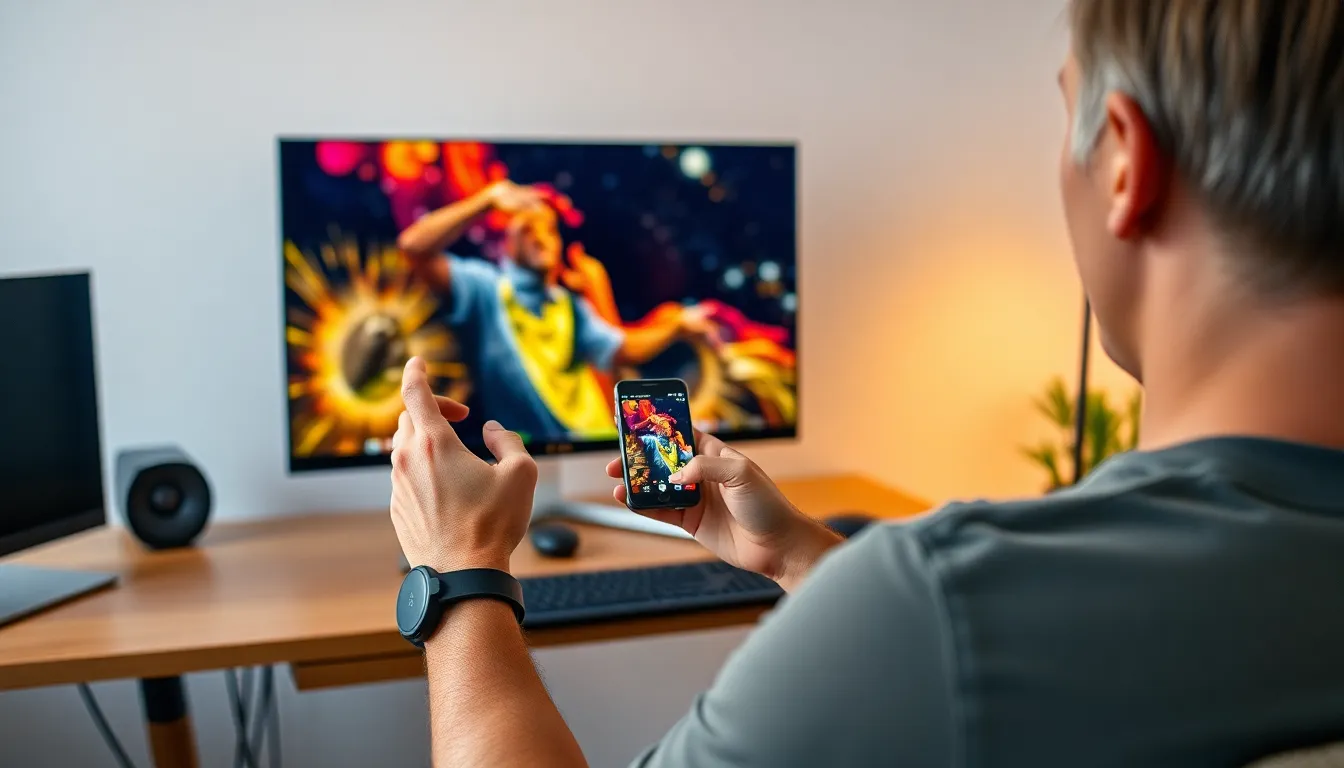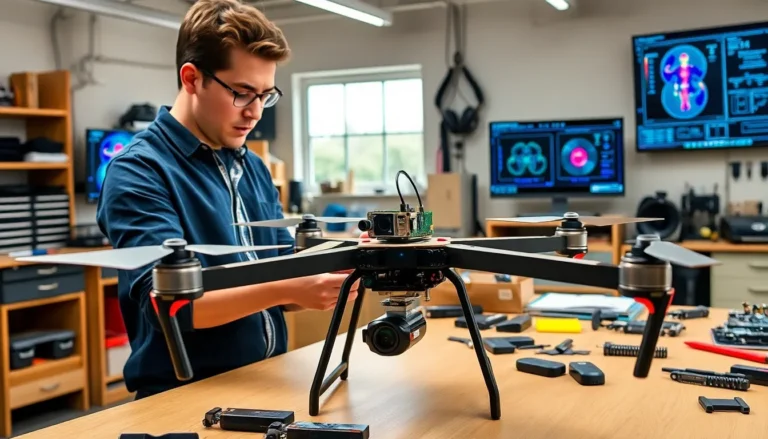Table of Contents
ToggleIn a world where multitasking reigns supreme, casting an iPhone to a computer can feel like discovering a hidden gem. Imagine effortlessly sharing your favorite cat videos or that epic vacation slideshow on a bigger screen without the hassle of cables and complicated setups. It’s like upgrading from a cozy studio apartment to a spacious penthouse—everyone wants in!
Understanding Screen Casting
Screen casting enables users to display an iPhone’s screen on a computer seamlessly. This technology simplifies sharing content, enhancing the overall viewing experience.
What is Screen Casting?
Screen casting refers to the process of transmitting the visual output of a device, such as an iPhone, to a larger display, like a computer screen. This method often uses wireless technology, allowing for real-time sharing without physical connections. Users can enjoy media, presentations, and apps directly on the computer, making it an efficient way to present information.
Benefits of Casting iPhone to Computer
Casting an iPhone to a computer offers several advantages. First, it enhances visibility; larger screens provide a better view for groups. Second, it facilitates collaboration, allowing multiple people to interact with content during meetings or gatherings. Third, it simplifies content sharing, enabling easy access to videos, photos, and games. Lastly, users experience improved multitasking, as they can operate both devices simultaneously for increased productivity.
Methods to Cast iPhone to Computer

Casting an iPhone to a computer offers multiple methods, each with its own advantages. Understanding the options helps users choose the best method for their needs.
Using AirPlay
AirPlay allows for seamless casting from an iPhone to a computer. Users need to ensure the computer supports AirPlay and that it’s connected to the same Wi-Fi network as the iPhone. In the control center on the iPhone, selecting the “Screen Mirroring” option displays available devices. Choosing the computer sends the iPhone’s screen to the larger display. This method excels in streaming videos, allowing for an enjoyable viewing experience on a bigger screen.
Using Third-Party Apps
Third-party apps provide versatile options for casting an iPhone to a computer. Applications like ApowerMirror and LonelyScreen facilitate this process without needing advanced technical skills. First, users must download the chosen app on their computer and the corresponding app on their iPhone. Connecting both devices through Wi-Fi enables users to start mirroring the iPhone’s screen. Multiple apps offer distinct features, including recording and file transfers, enhancing functionality during presentations or media sharing.
Steps for AirPlay Casting
AirPlay casting allows seamless sharing of an iPhone’s screen to a computer. Follow these steps to get started.
Requirements for AirPlay
AirPlay requires specific components for functionality. A compatible computer supporting AirPlay must be on the same Wi-Fi network as the iPhone. Macs come with built-in AirPlay, while Windows users may need additional software like iTunes or third-party applications. An updated iPhone running iOS 4.2 or later ensures smooth performance. Reliable Wi-Fi connectivity is crucial for uninterrupted streaming.
How to Enable AirPlay on Your iPhone
Enabling AirPlay on an iPhone involves straightforward steps. Start by accessing the Control Center; this can be done by swiping down from the upper-right corner on newer models or swiping up from the bottom on older versions. Look for the “Screen Mirroring” option and tap it. A list of available devices appears. Choose your computer from this list, and the connection establishes easily.
Connecting to Your Computer
Connecting to your computer requires additional attention. Ensure the computer is powered on and that AirPlay is enabled. If using software like LonelyScreen, open the application prior to casting. Once the iPhone detects the computer, a connection prompt may appear. Accept it to finalize the connection. Users can now enjoy real-time screen sharing, enhancing their viewing experience.
Steps for Third-Party Apps
Third-party apps simplify the process of casting an iPhone to a computer, offering various features for different user needs.
Popular Apps for Casting
ApowerMirror and LonelyScreen rank among the most recognized apps for casting. Users appreciate ApowerMirror’s robust features, including screen recording and file transfers. This app works well for both media sharing and presentations. LonelyScreen, on the other hand, focuses on straightforward screen mirroring. It provides an easy setup for users wanting quick access to their iPhone screen on a computer.
Installation and Setup Process
To install these apps, visit their official websites or download them from the App Store. ApowerMirror requires installation on both the iPhone and the computer. After downloading, follow the prompts to complete the setup. For a smooth connection, ensure both devices are on the same Wi-Fi network. Open the app on the computer and the iPhone, then select the device from the app interface. Users can initiate casting simply by tapping the screen mirroring option on their iPhone.
Troubleshooting Common Issues
Casting an iPhone to a computer can sometimes lead to common issues. Addressing these problems quickly ensures a seamless experience.
Connection Problems
Connection failures between the iPhone and the computer often stem from network issues. Users must verify both devices are on the same Wi-Fi network. Restarting both the iPhone and the computer frequently resolves intermittent connection problems. Updating the devices to the latest software enhances compatibility and performance. Checking for any interference from other devices can also improve connectivity stability. Ensuring the Wi-Fi signal is strong and consistent aids in preventing dropped connections during casting sessions.
Audio and Video Sync Issues
Audio and video sync issues can occur during casting sessions, disrupting the viewing experience. Adjusting the settings in the casting app often resolves these discrepancies. Using wired headphones connected to the computer may help achieve better audio synchronization. Ensuring both the iPhone and the computer are updated minimizes potential sync issues. Restarting the casting process can often realign the audio and video streams, enhancing overall performance. If problems persist, switching to a different casting app may provide a more stable experience.
Casting an iPhone to a computer opens up a world of possibilities for users. It enhances the viewing experience and simplifies sharing content in a way that feels both intuitive and efficient. Whether through AirPlay or third-party apps, the process is designed to be user-friendly and accessible.
With the right setup, anyone can enjoy the benefits of larger screens for presentations or media consumption. Troubleshooting common issues ensures a smooth experience, allowing users to focus on what matters most. Embracing this technology not only boosts productivity but also transforms how individuals interact with their devices.







